- Revenue Cycle Management
- COVID-19
- Reimbursement
- Diabetes Awareness Month
- Risk Management
- Patient Retention
- Staffing
- Medical Economics® 100th Anniversary
- Coding and documentation
- Business of Endocrinology
- Telehealth
- Physicians Financial News
- Cybersecurity
- Cardiovascular Clinical Consult
- Locum Tenens, brought to you by LocumLife®
- Weight Management
- Business of Women's Health
- Practice Efficiency
- Finance and Wealth
- EHRs
- Remote Patient Monitoring
- Sponsored Webinars
- Medical Technology
- Billing and collections
- Acute Pain Management
- Exclusive Content
- Value-based Care
- Business of Pediatrics
- Concierge Medicine 2.0 by Castle Connolly Private Health Partners
- Practice Growth
- Concierge Medicine
- Business of Cardiology
- Implementing the Topcon Ocular Telehealth Platform
- Malpractice
- Influenza
- Sexual Health
- Chronic Conditions
- Technology
- Legal and Policy
- Money
- Opinion
- Vaccines
- Practice Management
- Patient Relations
- Careers
Weimar: Small Town Germany
Weimar, a wonderful model of "small town Germany," boasts small shops, artisan stores, trade workplaces, unique museums - and it has a history.
Photography by the authors
Weimar, a wonderful model of “small town Germany,” boasts small shops, artisan stores, trade workplaces, unique museums — and it has a history.
Boy! Does it have a history, albeit a complicated one. Americans have a problem in European countries: as schoolchildren they’ve never had to assimilate those complex dates when great events happened, countries went to war and monarchs, many insignificant, came to rule.
The bishop-princes of the feudal states that later became Germany had reigns particularly unfamiliar to Americans. One reign involving Weimar was that of John Frederick the Magnanimous who died in 1554 at the age of 50. Fighting for the Reformation, he lost a battle against the Holy Roman Emperor Charles V in 1547 and was imprisoned with his famous court painter, Cranach the Elder, for five years. He survived execution by yielding most of his lands. He came to Weimar in 1552, impoverished and disgraced. Says our guide,
“There were Prussians to the North and Prussians to the East and all the way to the West nothing but farmland,” says our guide. “There was nothing here to let him redeem his name except perhaps sponsoring the arts.”
Thus, for more than two centuries artists and writers, avant-garde philosophers and celebrated intellectuals came to this little town. Of all those famous names of the past, the most respected in town is the Duchess Anna Amalie, the mother of and regent for Karl Augustus (1757-1828) who “was noted for the intellectual brilliance of his court.”
stammbuch
stammbuch
In 1776, Anna Amalie transferred the 3,000 books in the palace into what became the public library in the center of town. It now has one million volumes, of which one thousand are what German scholars call — autograph or friendship books. The Anna Amalia Bibliothek’s “Galileo and Goethe and Co” exhibits are the largest collection of in the world. The library itself is perhaps the most beautiful one sightseers could visit in Germany.
Weimar has recovered from its 40 years under the communist yoke, although it has taken East Germany surprisingly long to get past 1989 and into its future. Weimar (pop. 65,000) and Potsdam are said to be the only growing cities in the former East Germany.
Since the town is an easy walk and fairly flat, “We have more bicycles than cars,” says Anja Dietrich, director of Weimar Marketing

You see bicycles everywhere. You also see colorful, attractive buildings, each with its own history. The 1696 elephant sign arouses curiosity. The Elephant Inn became a stage stop here at an address on 19 Market that was mentioned as far back as 1542. It became a hotel in 1741. To it came Johann Wolfgang von Goethe, Friedrich Schiller, Leo Tolstoy, Thomas Mann, Franz Liszt, Richard Wagner and Johann Sebastian Bach.
That
Bach lived in an adjacent house, but the buildings including his home were knocked down in 1937 for space to create a more impressive hotel, the impetus coming from another guest at that time: Adolf Hitler. time, called Weimar Germany, was the period of German history after World War I that lasted until 1933 when Hitler came to power. And, of course, he came to the Hotel Elephant.
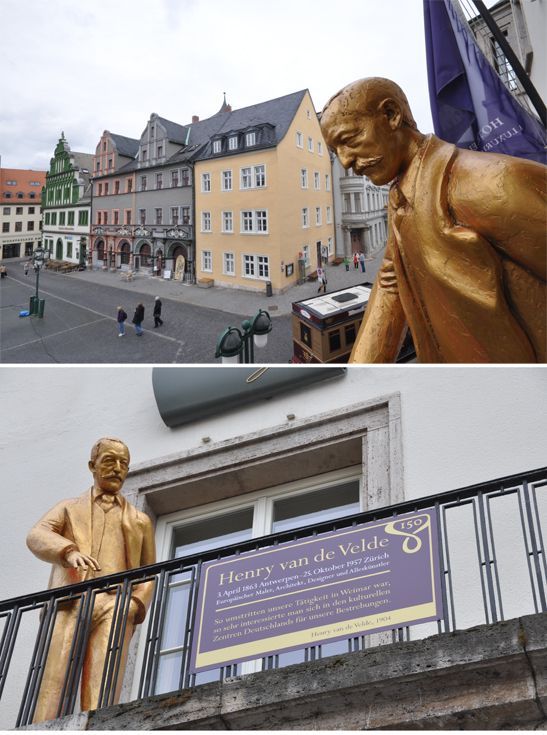
The hotel still dominates the Market Square as it has done for more than two centuries. The front room, whose balcony overlooks all the action on the square, is graced with a gilded statue of a past celebrity — Henry van de Velde, the Belgian architect and industrial designer who developed the precursor to the Bauhaus in Weimar.
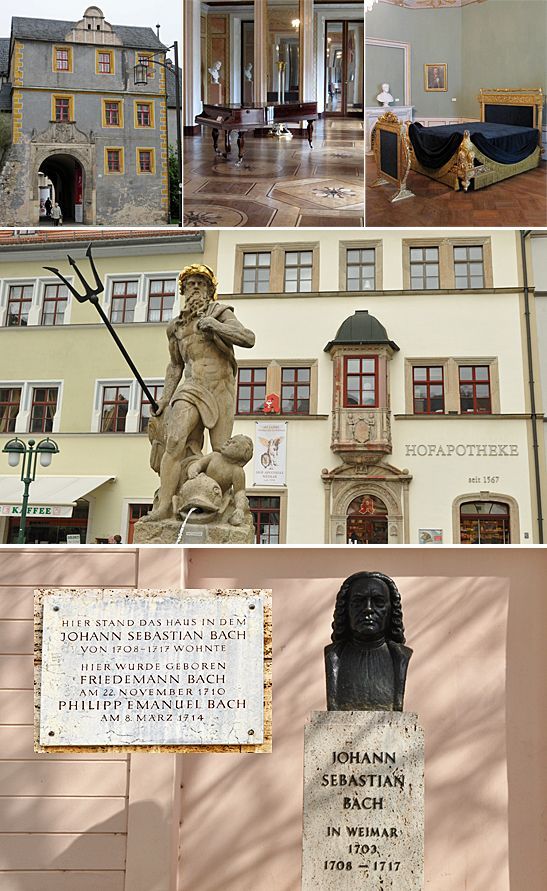
Everything you see in Weimar has its history, which explains why UNESCO designated three World Heritage Sites. The palace shows lavish furniture, including the one-time dowry of Maria Pawlowna, granddaughter of the Russian Tsarina Katharina II, who married into the Saxon royal family: a four poster canopy bed originally crowned with the Russian eagle.
The pharmacy in the Market Square sold medications to Martin Luther, who lived here for a short time and famously said, “I feel well here. I eat like a Bohemian and drink like a German!”
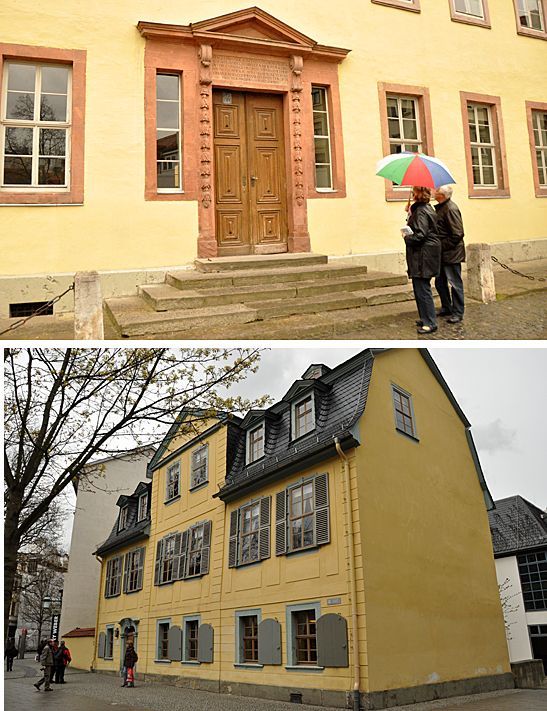
The former homes that attract the most attention are those of Goethe (top image) and Schiller, who became friends here in this classical and intellectual place. They command so much respect, even reverence, in the recollections of this small town that visitors would be wise to learn more about them than the average North American does.
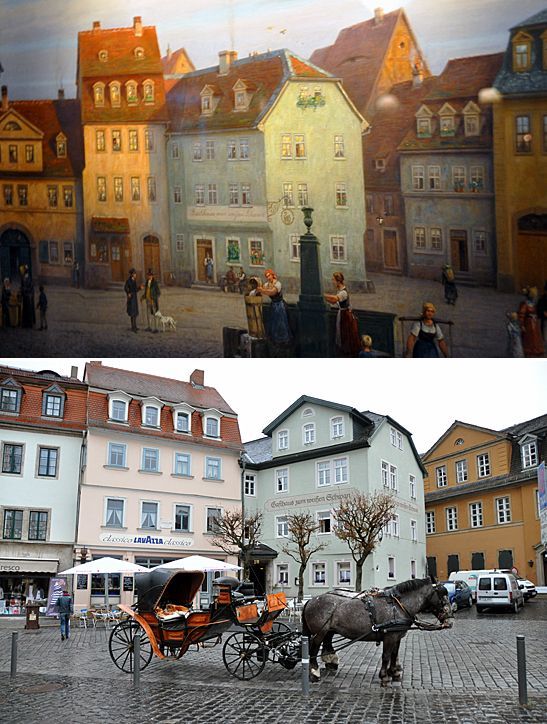
Love has a long memory and, as said before, Weimar has its history. A painting in the Swan Inn on the square at Frauenplan shows the plaza two centuries ago, and today’s photograph suggests it hasn’t really changed.

The parts of a town that go back to the Middle Ages always seems more colorful than today’s contemporary structures. The fun places in Weimar are the old buildings, old cars, tongue-in-cheek art and, of course, its majestic buildings and palaces.
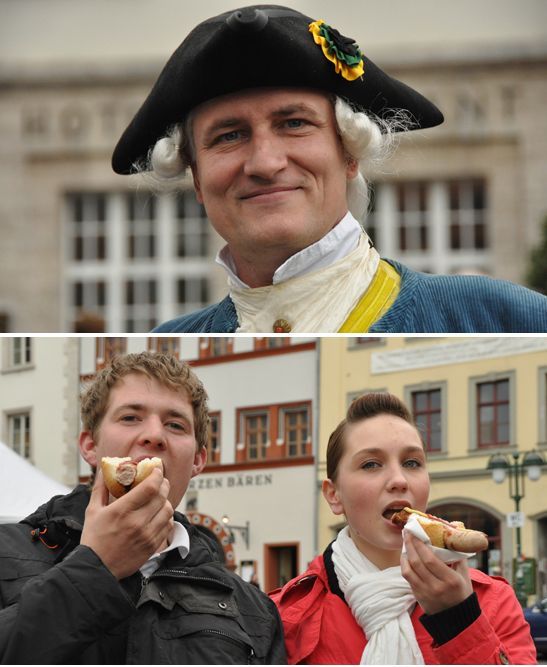
and
Thüringer rostbratwurst
and
The locals are loyal to their history. In season they might dress in costume to perform as tourist guides. Others, perhaps, are more loyal to their stomachs. A young German couple (eating smiling) walks by demonstrating why Burger King had to pull out of town. The fierce competition from the local fast food, a grilled in front of customers in the Market Square, was too much for the American outsider. Visiting travel writers from California soon, in their turn, are eating smiling, too.
The Man Who Cried Orange: Stories from a Doctor's Life.
The Andersons, who live in San Diego, are the resident travel & cruise columnists for Physician's Money Digest. Nancy is a former nursing educator, Eric a retired MD. The one-time president of the NH Academy of Family Practice, Eric is the only physician in the Society of American Travel Writers. He has also written five books, the last called
